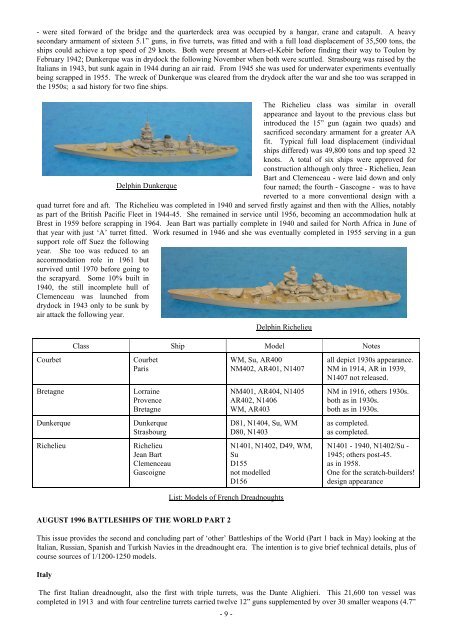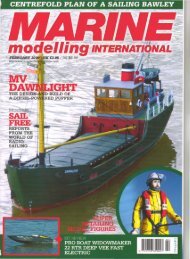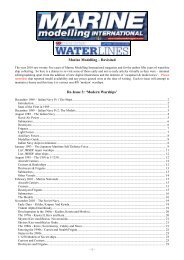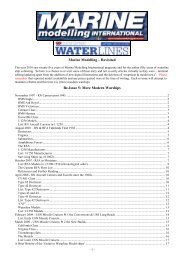Marine Modelling â Revisited Re-Issue 2: 'Foreign Warships'
Marine Modelling â Revisited Re-Issue 2: 'Foreign Warships'
Marine Modelling â Revisited Re-Issue 2: 'Foreign Warships'
You also want an ePaper? Increase the reach of your titles
YUMPU automatically turns print PDFs into web optimized ePapers that Google loves.
- were sited forward of the bridge and the quarterdeck area was occupied by a hangar, crane and catapult. A heavy<br />
secondary armament of sixteen 5.1” guns, in five turrets, was fitted and with a full load displacement of 35,500 tons, the<br />
ships could achieve a top speed of 29 knots. Both were present at Mers-el-Kebir before finding their way to Toulon by<br />
February 1942; Dunkerque was in drydock the following November when both were scuttled. Strasbourg was raised by the<br />
Italians in 1943, but sunk again in 1944 during an air raid. From 1945 she was used for underwater experiments eventually<br />
being scrapped in 1955. The wreck of Dunkerque was cleared from the drydock after the war and she too was scrapped in<br />
the 1950s; a sad history for two fine ships.<br />
The Richelieu class was similar in overall<br />
appearance and layout to the previous class but<br />
introduced the 15” gun (again two quads) and<br />
sacrificed secondary armament for a greater AA<br />
fit. Typical full load displacement (individual<br />
ships differed) was 49,800 tons and top speed 32<br />
knots. A total of six ships were approved for<br />
construction although only three - Richelieu, Jean<br />
Bart and Clemenceau - were laid down and only<br />
Delphin Dunkerque<br />
four named; the fourth - Gascogne - was to have<br />
reverted to a more conventional design with a<br />
quad turret fore and aft. The Richelieu was completed in 1940 and served firstly against and then with the Allies, notably<br />
as part of the British Pacific Fleet in 1944-45. She remained in service until 1956, becoming an accommodation hulk at<br />
Brest in 1959 before scrapping in 1964. Jean Bart was partially complete in 1940 and sailed for North Africa in June of<br />
that year with just ‘A’ turret fitted. Work resumed in 1946 and she was eventually completed in 1955 serving in a gun<br />
support role off Suez the following<br />
year. She too was reduced to an<br />
accommodation role in 1961 but<br />
survived until 1970 before going to<br />
the scrapyard. Some 10% built in<br />
1940, the still incomplete hull of<br />
Clemenceau was launched from<br />
drydock in 1943 only to be sunk by<br />
air attack the following year.<br />
Courbet<br />
Bretagne<br />
Dunkerque<br />
Richelieu<br />
Class Ship Model Notes<br />
Courbet<br />
Paris<br />
Lorraine<br />
Provence<br />
Bretagne<br />
Dunkerque<br />
Strasbourg<br />
Richelieu<br />
Jean Bart<br />
Clemenceau<br />
Gascoigne<br />
WM, Su, AR400<br />
NM402, AR401, N1407<br />
NM401, AR404, N1405<br />
AR402, N1406<br />
WM, AR403<br />
D81, N1404, Su, WM<br />
D80, N1403<br />
N1401, N1402, D49, WM,<br />
Su<br />
D155<br />
not modelled<br />
D156<br />
List: Models of French Dreadnoughts<br />
Delphin Richelieu<br />
all depict 1930s appearance.<br />
NM in 1914, AR in 1939,<br />
N1407 not released.<br />
NM in 1916, others 1930s.<br />
both as in 1930s.<br />
both as in 1930s.<br />
as completed.<br />
as completed.<br />
N1401 - 1940, N1402/Su -<br />
1945; others post-45.<br />
as in 1958.<br />
One for the scratch-builders!<br />
design appearance<br />
AUGUST 1996 BATTLESHIPS OF THE WORLD PART 2<br />
This issue provides the second and concluding part of ‘other’ Battleships of the World (Part 1 back in May) looking at the<br />
Italian, Russian, Spanish and Turkish Navies in the dreadnought era. The intention is to give brief technical details, plus of<br />
course sources of 1/1200-1250 models.<br />
Italy<br />
The first Italian dreadnought, also the first with triple turrets, was the Dante Alighieri. This 21,600 ton vessel was<br />
completed in 1913 and with four centreline turrets carried twelve 12” guns supplemented by over 30 smaller weapons (4.7”<br />
- 9 -







